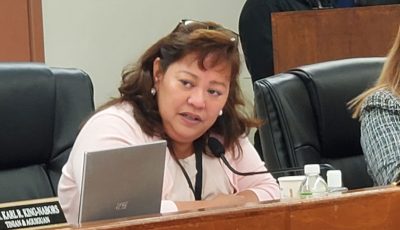DHS: CW cap at 13,999 for 2015
Only 1 less worker than 2014 cap of 14,000
The CNMI’s fiscal year 2015 numerical limit on Commonwealth-only workers is 13,999—only one foreign worker less than the 2014 CW cap of 14,000, according to an announcement by U.S. Department of Homeland Security Secretary Jeh Charles Johnson.
Gov. Eloy S. Inos said the new cap comes at an opportune time as a $7-billion integrated casino resort on Saipan, a $300-million casino resort on Tinian, a $130-million hotel resort also on Saipan, and many other major tourism development projects are underway.
The DHS secretary’s Friday announcement is set to be published in the Sept. 29, 2014, Federal Register.
The new cap meets the immigration federalization law’s requirement to reduce the annual CW numerical limitation until it reaches “zero” by the end of the transition period now set for 2019, while giving the CNMI continued access to skilled foreign labor still unmet by the U.S. worker pool.
“To comply with these requirements, meet the CNMI’s labor market’s needs, provide opportunity for growth, and preserve access to foreign labor, DHS has set the numerical limitation for FY 2015 at 13,199,” Johnson said.
DHS arrived at this figure by taking the number of CW-1 nonimmigrant workers needed based on the FY 2014 limitation of 14,000, and then nominally reducing it by one.
Delegate Gregorio Kilili C. Sablan (Ind-MP) said the new cap “is virtually unchanged from the FY14 cap of 14,000 and almost 4,000 more than the number who were granted CW status in FY13.”
“While investors and developers will be relieved that there will be ample labor available for hotels and other planned projects, we should not lose focus on the continuing need to train U.S. workers,” Sablan added.
Saipan Chamber of Commerce president Alex Sablan and other business leaders have long been seeking a CW cap that’s near the current cap or if possible, more than the current numeric limitation given the billion-dollar development projects in the CNMI beyond the end of the transition period in 2019.
In fiscal year 2011, DHS capped the number of CW-1s at 22,417. This went down by only one in fiscal 2012, or 22,416.
In fiscal 2013, the CW numerical limitation went down to 15,000. By fiscal 2014, the cap was pegged at 14,000.
DHS said the fiscal years 2013 and 2014 numerical limitations were based on the actual demonstrated need for foreign workers within the CNMI during fiscal 2012.
The Consolidated Natural Resources Act or the U.S. law that placed CNMI immigration under federal control requires an annual reduction in the number of transitional workers but does not mandate a specific reduction.
“It’s essentially a numerical reduction of one from the previous year. That met the statutory requirement that it must be reduced [every year until the end of transition period],” the governor said in an interview at the groundbreaking of Hong Kong-based Honest Profit International Ltd.’s $130-million, 300-room hotel in San Antonio on Saturday.
Inos said the CNMI, however, needs more than 13,999 workers “but it doesn’t necessarily mean that they all have to be CW workers.”
Besides the CW program, other U.S. immigration programs allow foreign workers to be hired in the CNMI including those under H visas.
The governor said allowing the CW program to continue until 2019 and setting the cap at 13,999 is one way to meet the CNMI’s labor needs.
Inos said he had conversations about the CW cap with U.S. Citizenship and Immigration Services Honolulu district director David Gullick.
“We exchanged ideas as to the numbers and so forth, but the final decision rests with USCIS and Homeland Security,” the governor added.
The CNMI delegate reiterated that the CNMI must stay focused on training workers.
Citing U.S. Department of Labor data, Sablan said unemployed U.S. workers could fill as many as 20 percent of the available jobs, “if the unemployed had the right skills.”
“Our local government has the responsibility for using effectively the $1.5 million it receives each year in CW fees to train U.S. workers. And employers have the responsibility always to hire locals, if they have the skills and are ready to work. U.S. Public Law 110-229 still requires that there be zero CW workers by the end of 2019,” Sablan said.



























